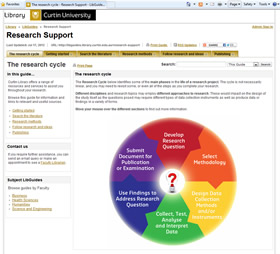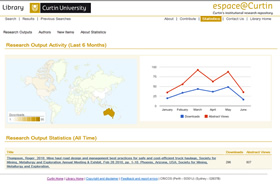
Research support and espace, Curtin's institutional repository
Research support
Senior librarians based in each faculty provided front line support for academics and postgraduate research students under the successful model established in the second half of the 1990s. One-to-one assistance and group training sessions remained an important part of the service but in the 2000s, web-based information literacy and research support packages became increasingly important.
The development of more sophisticated and accessible online resources meant greater equity of access for the many researchers not located on the Bentley campus. InfoTrekk Plus, iLectures of training sessions, podcasts and a research support LibGuide were some of the most significant online offerings for researchers.
Additionally, the faculty (formerly senior) librarians were being assisted in research support activities to a greater degree by other staff in the Research and Learning Services unit.
From 2009 on, the Library was involved in the University’s e-Research group and provided significant input into the development of a research data management system for Curtin.
Library staff also provided support for specialised metrics analysis for the Office of Research and Development and for the faculties and supported open access to Curtin research through the continuing development of the University’s institutional repository, espace@Curtin.
espace, Curtin’s institutional repository
The Library was an early leader amongst Australian university libraries in its development of an institutional repository to provide open access to the research of Curtin academics.
Branded espace@Curtin, the repository initially ran on the eprints software platform. Following a successful pilot program in 2003, the repository was launched in early 2004 and by May the next year, it was providing access to some 260 papers.
Initially, Library staff efforts centred on establishing processes to ensure good management of copyright permissions and on building content by encouraging researchers to contribute their publications.
In 2007, staff from the University’s Office of Research and Development (ORD) and the Library worked together to develop a system which enabled the automatic transfer of papers deposited in ORD’s new publications management system to the repository. This increased efficiency as researchers only had to enter their publication information into a single database. Library staff then followed up author and publisher permissions and processed the papers to open access in espace@Curtin where possible.
Both view and download statistics for papers and their authors were developed, including statistics for ‘top authors’ and ‘top papers’ which proved popular with researchers.
When the repository migrated to the the Ex Libris Digitool platform in 2009, the Curtin digital theses were incorporated into the repository content.
The same year, the Library worked with ORD to enable a restricted version of the repository to provide access to selected research publications as part of the external peer review assessment in the Excellence in Research Australia pilot. Building on this initial success, the same approach was used in the 2010 and 2012 Excellence in Research Australia processes.
s.jpg) Clients receiving assistance from a Library staff member at the information desk on level three, 2004.
Clients receiving assistance from a Library staff member at the information desk on level three, 2004.
 Screenshot of the Library's research support LibGuide, 2012.
Screenshot of the Library's research support LibGuide, 2012.
 Screenshot from an espace statistics page for a particular paper, 2012. Activity maps and graphs provide visual representations of world-wide usage statistics over time (views and downloads).
Screenshot from an espace statistics page for a particular paper, 2012. Activity maps and graphs provide visual representations of world-wide usage statistics over time (views and downloads).
By mid 2010, espace@Curtin showcased more than 9 000 Curtin research outputs (including digital theses), of which about 65% were open access. Activity visualisation maps for author and paper statistics were an innovative addition to the espace pages at this time.